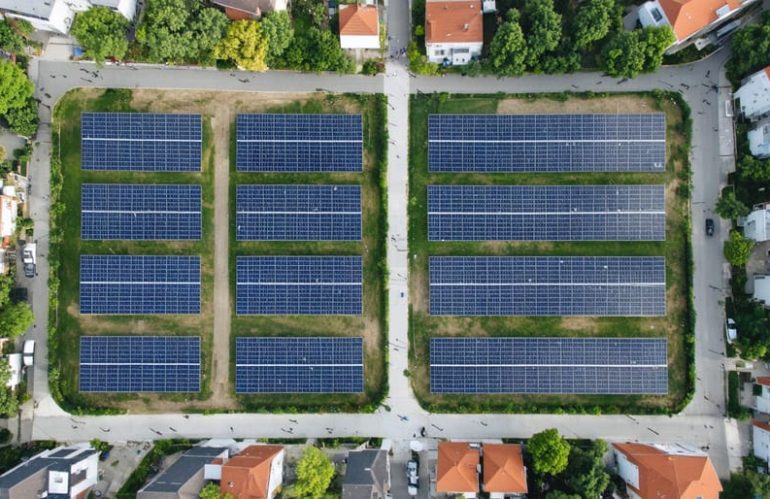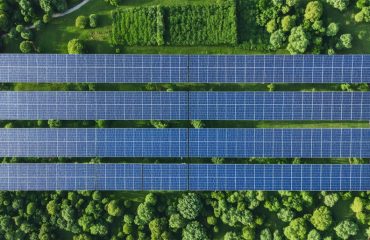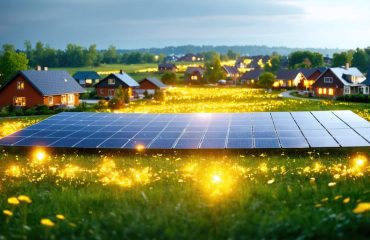As America’s solar energy landscape evolves, the choice between community and utility solar programs stands at a crucial crossroads. While both options advance renewable energy adoption, they serve distinctly different needs and communities. Community solar projects, typically smaller and locally managed, enable renters, apartment dwellers, and homeowners with unsuitable roofs to access solar power through shared installations. In contrast, utility-scale solar farms generate massive amounts of clean energy for the broader power grid, offering economies of scale but less direct community involvement.
The growing demand for sustainable energy solutions has sparked intense interest in both models, particularly as communities seek ways to democratize solar access and reduce energy costs. Understanding the key differences between these approaches – from investment requirements and environmental impact to energy bill savings and community benefits – helps individuals and municipalities make informed decisions about their energy future. This comparison explores how each model shapes our transition to renewable energy, examining their unique advantages and challenges in creating a more sustainable and equitable energy landscape.
How Community Solar Brings Power to the People
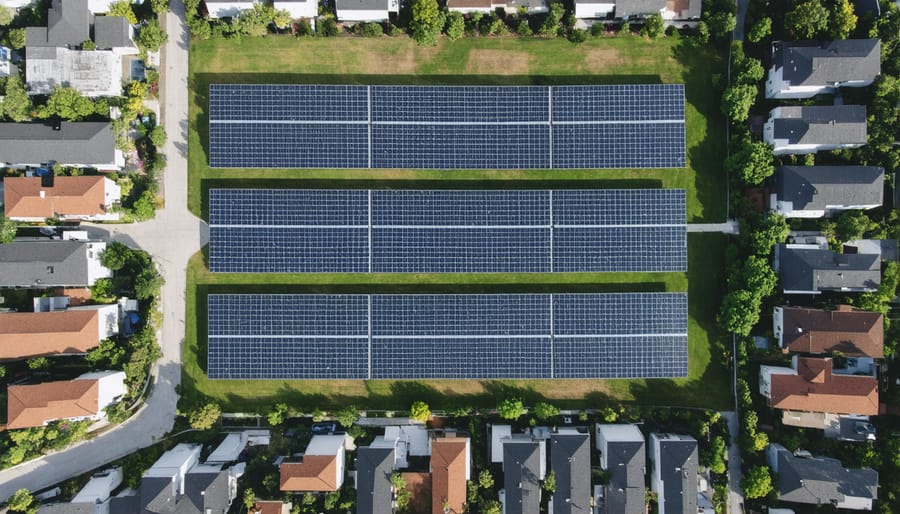
What Makes Community Solar Different
Community solar takes a unique approach by allowing multiple participants to benefit from a single solar installation, typically located off-site in a sunny, optimal location. Unlike utility solar programs, community solar operates on a subscription or ownership model where residents can purchase or subscribe to a portion of the solar farm’s output.
What makes this setup particularly attractive is its flexibility and accessibility. Participants don’t need to install panels on their property, making it ideal for renters, apartment dwellers, or homeowners with unsuitable roofs. The energy credits earned from your share of the solar farm are automatically applied to your regular electricity bill, creating a seamless experience.
Community solar projects often feature local ownership and management, keeping the benefits within the community. Many programs offer flexible terms, allowing subscribers to opt out if they move or their circumstances change. This low-risk approach eliminates common barriers to solar adoption, such as high upfront costs and long-term commitments.
Additionally, these projects frequently incorporate community engagement initiatives, environmental education programs, and local job creation, making them true community assets rather than just power generation facilities.
Breaking Down the Cost Barrier
One of the most significant advantages of community solar is its ability to make clean energy accessible to a broader range of households. Traditional rooftop solar installations often require substantial upfront investments, but community solar savings can be achieved with little to no initial costs. Subscribers typically save 10-15% on their electricity bills from day one, making it an attractive option for budget-conscious consumers.
Unlike utility solar, community solar programs often feature flexible subscription models that don’t require long-term commitments or property ownership. This opens up solar access to renters, apartment dwellers, and homeowners whose properties aren’t suitable for rooftop installations. Many programs also offer pay-as-you-go options and allow subscribers to transfer their subscription if they move within the same utility territory.
The cost-sharing model of community solar helps distribute expenses across multiple participants, reducing individual financial burden while maximizing collective benefits. Additionally, many states offer incentives and programs specifically designed to make community solar more accessible to low and moderate-income households, further breaking down traditional economic barriers to clean energy adoption.
Utility Solar: The Traditional Approach
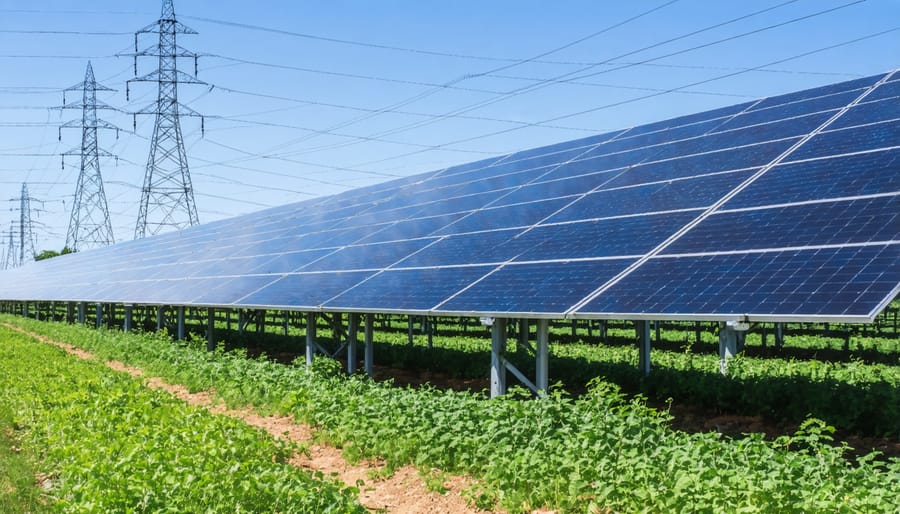
The Utility Solar Model
Utility solar represents a traditional approach to renewable energy, where large power companies build and operate massive solar farms that feed directly into the electrical grid. These solar installations typically span hundreds of acres and can generate enough electricity to power thousands of homes and businesses.
When you pay your regular electricity bill, some of that power may come from these utility-scale solar facilities, alongside other energy sources like wind, natural gas, or coal. The utility company manages all aspects of these solar farms, from installation and maintenance to power distribution, making it a hands-off experience for consumers.
The main advantage of utility solar is its efficiency of scale – large installations can produce power at lower costs than smaller setups. However, individual customers don’t directly benefit from reduced energy costs unless the utility company passes those savings along through lower rates.
This model has helped increase renewable energy adoption across the country, but it doesn’t offer the same level of personal involvement or guaranteed savings that other solar options provide. Customers remain traditional utility consumers, with little control over their energy sources or costs.
Access and Affordability Challenges
Despite the growing popularity of utility solar programs, several barriers prevent many households from participating. The most significant challenge is the high upfront cost of installing solar panels, which can range from $15,000 to $25,000 for a typical home system. This financial hurdle effectively excludes many low-to-middle-income families from accessing solar benefits.
Property requirements pose another major obstacle. Renters, apartment dwellers, and homeowners with unsuitable roofs (due to shade, orientation, or structural issues) are often unable to participate in traditional utility solar programs. Additionally, strict credit score requirements and long-term commitments can make these programs inaccessible to many potential participants.
Geographic limitations also play a role, as utility solar programs may not be available in all service areas. Some utilities have caps on the number of customers who can participate in their solar programs, creating waiting lists or completely closing off access to new participants.
These accessibility challenges disproportionately affect urban residents, lower-income communities, and minority populations, highlighting the need for more inclusive solar energy solutions.
Real Impact on Underserved Communities

Success Stories and Case Studies
The success of community solar is evident in numerous projects across the country. In Massachusetts, the Lexington Community Solar Farm serves over 130 households, reducing their electricity bills by an average of 15% while preventing 1,500 metric tons of carbon emissions annually. This project particularly benefits renters and low-income families who previously couldn’t access solar energy benefits.
Colorado’s Clean Energy Collective demonstrates how utility partnerships can work effectively. Their community solar gardens serve over 2,000 subscribers across multiple counties, with participants saving an average of $300 annually on energy costs. The project also created local jobs and contributed to the state’s renewable energy goals.
In Minnesota, the Xcel Energy Community Solar Garden program has become a national model for success. Since its launch, it has grown to over 800 megawatts of operational capacity, enough to power 100,000 homes. Subscribers typically save 5-10% on their electricity bills, and many gardens include designated capacity for low-income households.
New York’s Solar For All program shows how community solar can specifically target underserved populations. The initiative provides guaranteed electricity bill savings to 10,000 low-income households with no upfront costs or fees, demonstrating how community solar can address energy equity issues while advancing clean energy goals.
These success stories showcase community solar’s ability to make renewable energy accessible and affordable while strengthening local communities.
Overcoming Implementation Challenges
Expanding solar access requires addressing several key challenges, but innovative solutions are making it easier than ever to participate in solar energy programs. For communities facing financial barriers, new financing models like pay-as-you-go subscriptions and sliding-scale payment options have made solar more accessible to lower-income households.
Local governments and utilities are increasingly offering incentive programs and grants specifically designed to help underserved communities launch a community solar project. These programs often include technical assistance and support throughout the development process.
Education and outreach play crucial roles in overcoming awareness barriers. Success stories from existing projects help demonstrate the benefits and feasibility of solar initiatives. Many communities are partnering with local organizations to conduct workshops, creating multilingual resources, and establishing solar ambassador programs to spread accurate information.
Zoning and permitting challenges can be addressed through streamlined processes and updated regulations. Some municipalities have created solar-friendly ordinances and expedited permit reviews for community projects. Additionally, innovative land-use solutions, such as using brownfield sites or incorporating solar into existing infrastructure, help overcome space limitations in urban areas.
By combining these strategies with strong community engagement and support from local leaders, both community and utility solar programs can successfully expand clean energy access to more residents.
Making the Right Choice for Your Community
When deciding between community and utility solar options, it’s essential to evaluate your specific circumstances and community needs. Start by assessing your property situation – if you rent, have a shaded roof, or live in a multi-unit building, community solar might be your ideal choice. Homeowners with suitable roofs and the financial means for installation might find utility solar more advantageous.
Consider your financial goals and available incentives. Community solar typically requires no upfront costs and offers immediate savings on energy bills, making it an accessible option for many households. Utility solar involves initial investment but can provide greater long-term savings and increase property value. Research local and state incentives available for both options, as these can significantly impact your decision.
Your community’s characteristics also play a crucial role. Areas with limited roof space or many rental properties might benefit more from community solar projects, which support solar access for all communities. Consider consulting local solar advocates or energy advisors who can provide insights specific to your area.
Think about your commitment level. Community solar offers flexibility with subscription-based models, while utility solar requires more long-term commitment but gives you complete control over your system. Review contract terms carefully, including cancellation policies for community solar or warranty coverage for utility installations.
Remember, both options contribute to reducing carbon emissions and supporting renewable energy adoption. The best choice depends on balancing your personal circumstances, financial capabilities, and community needs with the available options in your area.
Both community solar and utility solar programs offer valuable pathways to clean energy adoption, each with distinct advantages. Community solar shines in its ability to make solar power accessible to renters, apartment dwellers, and those with unsuitable roofs, while utility solar excels in large-scale renewable energy deployment. The choice between them often depends on your specific circumstances, location, and energy goals.
Whether you opt for community solar’s flexible subscription model or support utility-scale projects through your power company, you’re contributing to a cleaner energy future. Consider your living situation, budget, and local options to make the best choice for your needs. Don’t wait to take action – research available programs in your area today and join the growing movement toward sustainable energy. Your participation, whether through community or utility solar, helps create a more sustainable and equitable energy landscape for everyone.

